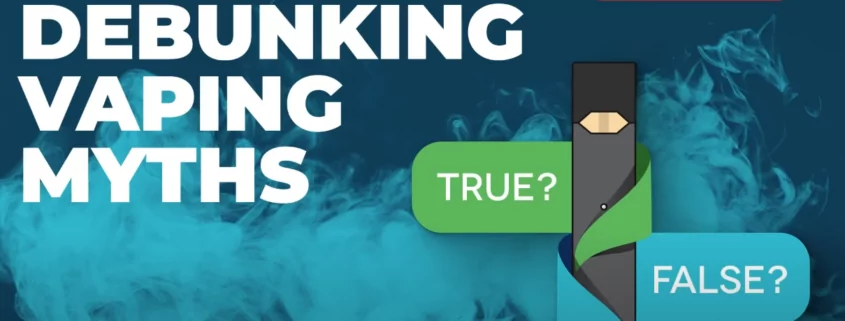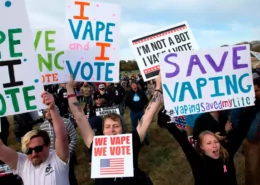CASSAA Video Debunking Common Vaping Myths
CASAA, a non-profit vape advocacy organization, is dedicated to representing the interests of vapers in relation to Tobacco Harm Reduction. As part of their efforts to educate the public about the potential of vaping products as smoking cessation and harm reduction tools, CASAA has recently released a video aiming to debunk some of the most commonly repeated vaping myths. In this article, we will explore the myths surrounding vaping and the evidence that debunks them, using information from CASAA, CDC NYTS & NHIS data, and renowned public health experts.
Myth 1: Vaping causes popcorn lung
One of the most prevalent myths about vaping is that it causes popcorn lung, a condition known as bronchiolitis obliterans. This myth originated from a study conducted in 2015 that found high levels of diacetyl, a harmful chemical, in some e-liquids. However, it is important to note that diacetyl has been banned as an ingredient in e-liquids in many countries, including the United States, and reputable e-liquid manufacturers do not use it in their products.
CASAA, in their video, debunks this myth by citing research from the Royal College of Physicians, which states that the risk of developing popcorn lung from vaping is negligible. The levels of diacetyl found in e-liquids are significantly lower than those found in the study that initially raised concerns, and the risk of developing popcorn lung from vaping is minimal compared to the risks associated with smoking traditional cigarettes. This myth has been perpetuated by misinformation and fearmongering, and it is important to rely on credible sources for accurate information about vaping.
Myth 2: E-cigarettes don’t help people quit smoking
Another common myth about vaping is that e-cigarettes are not effective in helping people quit smoking. However, research and real-world evidence show otherwise. CASAA, using CDC NYTS & NHIS data, released infographic graphs last year that revealed for every one teen who vapes regularly, nearly FIVE adults quit smoking. This data suggests that e-cigarettes can be a valuable tool in smoking cessation efforts.
In their video, CASAA highlights the fact that many vapers are former smokers. The graphs show that there are currently 3.95 million current vapers who are former smokers, indicating that vaping has helped them quit smoking. Additionally, there are 2.74 million vapers who are non-regular smokers, and 2.44 million vapers who are current smokers. This data suggests that e-cigarettes are being used as a harm reduction strategy by former smokers, as well as by those who are trying to quit or reduce their smoking habit.
CASAA’s video also emphasizes the importance of personalized quit plans and the availability of a wide range of vaping products with different nicotine strengths, which allows users to gradually reduce their nicotine intake and eventually quit vaping altogether if they choose to do so. This evidence contradicts the myth that e-cigarettes are not effective in helping people quit smoking and supports their potential as a harm reduction tool.
Myth 3: E-liquids contain anti-freeze
A common myth about e-liquids is that they contain anti-freeze, a toxic substance. This myth is misleading and false. E-liquids do not contain anti-freeze. The confusion may have arisen from the fact that some e-liquids contain propylene glycol (PG), which is a common ingredient in anti-freeze. However, PG is also used in many other everyday products such as food, cosmetics, and medications, and it is generally recognized as safe for human consumption by regulatory authorities.
CASAA’s video debunks this myth by clarifying that e-liquids do not contain anti-freeze and that the confusion arises from the fact that propylene glycol, which is a common ingredient in some e-liquids, is also used in anti-freeze. However, the form of propylene glycol used in e-liquids is pharmaceutical grade and safe for human consumption. It is important to understand that e-liquids are formulated with specific ingredients and are subject to regulations and standards to ensure their safety.
Myth 4: Vaping is just as harmful as smoking
There is a common misconception that vaping is just as harmful as smoking traditional cigarettes. However, this myth is not supported by scientific evidence. CASAA’s video presents information from renowned public health experts, such as Dr. Konstantinos Farsalinos and Dr. Riccardo Polosa, who have conducted extensive research on the safety of vaping.
According to the video, studies have shown that the harmful chemicals in e-cigarette aerosol are significantly lower in quantity and concentration compared to the harmful chemicals in cigarette smoke. While e-cigarette aerosol is not harmless, it is widely recognized that vaping is less harmful than smoking. Public Health England, an authoritative public health organization in the UK, has estimated that vaping is at least 95% less harmful than smoking.
CASAA’s video also emphasizes that vaping is not completely risk-free, especially for youth, pregnant women, and individuals with certain health conditions. However, for adult smokers who switch to vaping, it is a less harmful alternative that can significantly reduce their exposure to harmful chemicals found in cigarettes.
Myth 5: Vaping leads to smoking initiation among youth
There is a concern that vaping may lead to smoking initiation among youth. However, the evidence to support this myth is limited and inconclusive. CASAA’s video highlights data from the CDC NYTS & NHIS that shows that most youth who vape are either current or former smokers, and only a small proportion of youth who vape have never smoked.
According to the video, there is evidence that vaping may be displacing smoking among youth, meaning that youth who would have otherwise initiated smoking are instead choosing to vape. While youth vaping is a concern that should be addressed through appropriate regulations and policies, it is important to recognize that vaping is not the primary cause of smoking initiation among youth, and other factors such as peer influence, social and environmental factors, and access to cigarettes play a significant role.
Conclusion
In conclusion, CASAA’s video debunks several common myths about vaping using evidence from reputable sources and renowned public health experts. Vaping is not without risks, but it is widely recognized as a less harmful alternative to smoking for adult smokers. E-cigarettes have been shown to be effective in helping smokers quit or reduce their smoking, and the risks associated with vaping are significantly lower than those associated with smoking traditional cigarettes. It is important to rely on accurate information from credible sources when discussing vaping and its potential as a harm reduction tool.
- Teen Vaping of THC & Synthetic Cannabinoids Surges: Study - July 4, 2025
- UK Wolverhampton Extends “Swap to Stop” Vape Program - July 4, 2025
- Pakistan Halts Vape Crackdown Pending Legislation - July 4, 2025









